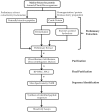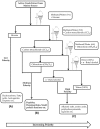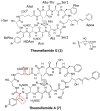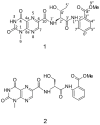Peptides, Peptidomimetics, and Polypeptides from Marine Sources: A Wealth of Natural Sources for Pharmaceutical Applications
- PMID: 28441741
- PMCID: PMC5408270
- DOI: 10.3390/md15040124
Peptides, Peptidomimetics, and Polypeptides from Marine Sources: A Wealth of Natural Sources for Pharmaceutical Applications
Abstract
Nature provides a variety of peptides that are expressed in most living species. Evolutionary pressure and natural selection have created and optimized these peptides to bind to receptors with high affinity. Hence, natural resources provide an abundant chemical space to be explored in peptide-based drug discovery. Marine peptides can be extracted by simple solvent extraction techniques. The advancement of analytical techniques has made it possible to obtain pure peptides from natural resources. Extracted peptides have been evaluated as possible therapeutic agents for a wide range of diseases, including antibacterial, antifungal, antidiabetic and anticancer activity as well as cardiovascular and neurotoxin activity. Although marine resources provide thousands of possible peptides, only a few peptides derived from marine sources have reached the pharmaceutical market. This review focuses on some of the peptides derived from marine sources in the past ten years and gives a brief review of those that are currently in clinical trials or on the market.
Keywords: antifungal peptides; antimicrobial peptides; extraction of peptides; marine peptides.
Conflict of interest statement
The authors declare no conflict of interest.
Figures











Similar articles
-
New Peptides Isolated from Marine Cyanobacteria, an Overview over the Past Decade.Mar Drugs. 2017 May 5;15(5):132. doi: 10.3390/md15050132. Mar Drugs. 2017. PMID: 28475149 Free PMC article. Review.
-
Recent Advances in the Discovery and Development of Marine Natural Products with Cardiovascular Pharmacological Effects.Mini Rev Med Chem. 2018;18(6):527-550. doi: 10.2174/1389557517666170927112621. Mini Rev Med Chem. 2018. PMID: 28969542 Review.
-
Marine-Derived Bioactive Peptides for Biomedical Sectors: A Review.Protein Pept Lett. 2017;24(2):109-117. doi: 10.2174/0929866523666160802155347. Protein Pept Lett. 2017. PMID: 27491381 Review.
-
Marine Peptides as Anticancer Agents: A Remedy to Mankind by Nature.Curr Protein Pept Sci. 2017;18(9):885-904. doi: 10.2174/1389203717666160724200849. Curr Protein Pept Sci. 2017. PMID: 27455970 Review.
-
Alkynyl-Containing Peptides of Marine Origin: A Review.Mar Drugs. 2016 Nov 23;14(11):216. doi: 10.3390/md14110216. Mar Drugs. 2016. PMID: 27886049 Free PMC article. Review.
Cited by
-
Discovery of a New Analgesic Peptide, Leptucin, from the Iranian Scorpion, Hemiscorpius lepturus.Molecules. 2021 Apr 28;26(9):2580. doi: 10.3390/molecules26092580. Molecules. 2021. PMID: 33925223 Free PMC article.
-
Physicochemical Properties and Biocompatibility Evaluation of Collagen from the Skin of Giant Croaker (Nibea japonica).Mar Drugs. 2018 Jun 29;16(7):222. doi: 10.3390/md16070222. Mar Drugs. 2018. PMID: 29966234 Free PMC article.
-
Bioactivities, Applications, Safety, and Health Benefits of Bioactive Peptides From Food and By-Products: A Review.Front Nutr. 2022 Jan 20;8:815640. doi: 10.3389/fnut.2021.815640. eCollection 2021. Front Nutr. 2022. PMID: 35127796 Free PMC article. Review.
-
Antioxidant and Antimicrobial Peptides Derived from Food Proteins.Molecules. 2022 Feb 16;27(4):1343. doi: 10.3390/molecules27041343. Molecules. 2022. PMID: 35209132 Free PMC article. Review.
-
Targeting protein-protein interaction for immunomodulation: A sunflower trypsin inhibitor analog peptidomimetic suppresses RA progression in CIA model.J Pharmacol Sci. 2022 Jul;149(3):124-138. doi: 10.1016/j.jphs.2022.04.005. Epub 2022 Apr 25. J Pharmacol Sci. 2022. PMID: 35641025 Free PMC article.
References
-
- Buchwald H., Dorman R.B., Rasmus N.F., Michalek V.N., Landvik N.M., Ikramuddin S. Effects on GLP-1, PYY, and leptin by direct stimulation of terminal ileum and cecum in humans: Implications for ileal transposition. Surg. Obes. Relat. Dis. 2014;10:780–786. doi: 10.1016/j.soard.2014.01.032. - DOI - PMC - PubMed
Publication types
MeSH terms
Substances
Grants and funding
LinkOut - more resources
Full Text Sources
Other Literature Sources
Miscellaneous

